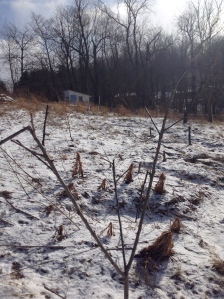
For the most part, things look as alive as they get in January-February time here, not very alive. I was worried about my plants since we hit well below zero — 25 below zero farenheit, actually. From all I could tell though, they look alive. If some of them do freeze to the ground, it’s a natural pruning.
Another less welcome form of pruning I found while inspecting the plants is deer nipping off tips of my trees where I thought they never would come, and mice chewing the bark off some of my shrubs.
Being optimistic, I’d like to point out that the deer have essentially pruned my trees in the most natural way possible. This is less work for me, and a better job of pruning than I would have done if I did prune (I don’t). Just a slight nip at the tips will encourage a nice thick growth from all the buds left behind.
You might wonder how mice chewing off bark could ever be a good thing? Well, it’s mixed. Scar tissue isn’t all that great for allowing sap flow as far as I know, but it does allow the cambium layer to expand in the healing process so there’s more room for sap flow.
Perhaps you’ve read in some of the more archaic gardening books that if a tree won’t fruit, the gardener should threaten to cut the tree’s throat? If the tree further refuses to fruit, it is recommended the gardener do just that — take a knife and make a big gash in the bark at the base of the tree, and it will fruit. Either this method, or I have read of driving nails into a tree, lashing it with a whip, shooting a gun into the branches around new years, tons of crazy stuff. All these were thought to “waken the tree spirit,” hence, making it fruit.
Why this works is it partially constricts the flow of sap, stressing the tree, making the tree think it has to produce seed fast. It is the same reason why dwarf rootstock makes a tree fruit earlier and heavier in its life than standard rootstock.
With dwarf rootstocks though, the stress is never relieved. As a result, they have a shorter lifespan, and less resistance to disease usually; whereas the old method of ‘cutting its throat’ lets the tree heal with better cambium flow. Certainly a better choice than restricting it for life.
I’m not going to do either of these, and I’m not recommending you go hacking at any lazy tree you come upon –risky business over just giving the tree a healthy plant guild around it and waiting. I’m just pointing out that mice and deer chewing the trees, if not too harsh, really isn’t all that bad.

Last year I had far worse when my Sister’s goats nearly girdled my trees entirely. I put a salve of Betonite clay mixed with biodynamic preps onto the trees to help them heal, since the wounds were so extensive. The trees put on decent growth over the summer though, and seem to have recovered very well. I will apply some salve to these newly bit trees this year to help them heal.
It’s brutal here. But I will be getting my spring soon enough.




Lovely post! In contrast to your very harsh winter in the UK we have had exceptionally mild temperatures, alongside the most rain for 250 years apparently. Last year was bitter cold. our gardens all need to be resilient and adaptable.
LikeLike
So true! Resilience and ability to adapt is the most important characteristic a garden and its individual plants can have. Thanks for pointing that out.
LikeLike